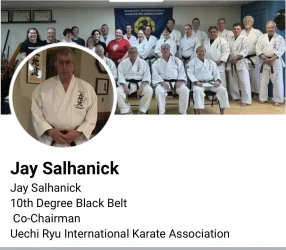Let me see if I got this. In late 1800's there was a community of Okinawans living in Fujian Province, China. Kanbun Uechi wanted to avoid the Japanese draft so he went to Fujian Province, China. While there he, and other Okinawans, studied Chinese Martial Arts. The exact style he studied is unknown. After a period of time he and othere Okinawans returned to Okinawa. They combined what they learned in China with traditional Okinawan Martial Arts and created Karate. The most famous of these were located in three cities and their styles were named after the cities in which they were located and became known as Shuri-Te, Naha-Te or Tomari-Te. These evolved into what is now known as
Shorin-ryu,
Wado-ryu,
Shito-ryu,
Goju-ryu, Shotokan,
Isshin-ryū, Kyokushin and others.
Kanbun Uechi's experience was somewhat different. In that he taught or created a style called Pangai No'on (Pangainoon). This style was based mostly upon what he learned in China and was not influenced by Okinawan Martial arts to the extent the other styles were. Thus, it is seen as more traditional (Chinese) than the others and not descended from them. He eventually moved to mainland Japan and taught his style. He eventually returned to Okinawa and opened a Dojo there. His son Kanei Uechi renamed the style Uechi Ryu after his farther's death in 1948.
This painting with a broad brush, I know. But does this bare any resemblence to what actually happened?
Uechi- ryu can be divided into a few different time periods. Thus the confusion because each period is different.
Kanbun studied in Fujian China, ok we know that. For lack of a better term in this discussion I will call those styles Chinese Quan systems. At that time most Quan did not have defined names. They could be regional, village or even family styles. The closest living style relative that I have found is the Tan family Respecting Tiger, Huzun Quan. Oral history says that kanbun studied under Shu shi wa (japanese name) or Zhou Zi He in Chinese. Zhou studied under Zheng Bu Su. Both of these teachers are very well known in China and both made alterations to the Huzun Quan style. It should be noted that Zhou was known to have studied multiple styles.
So why didn't Kanbun call his style Huzun Quan? But more questionable is that the style Zhou passed down still exists in China and the forms do not look like uechi- ryu. They are completely different. However like I said uechi forms DO LOOK LIKE Tan family Huzun Quan. So that's an interesting puzzle that I will leave open because to answer would be speculation.
Kanbun taught for many years in China. He taught Chinese martial arts in China, it was not Karate. It was traditional Chinese Quan style. History tells us that this was a tumultuous time. It was right after the Boxer rebellion and there was a public and government movement to prosecute Martial artists. It's probable that Kanbun left China for this reason.
From there he moved to Wakiyama around 1929 ( i would have to look it up for exact date) at this time Funakoshi, Motobu, Mabuni and maybe others were already in Japan teaching Okinawan Tode, later to be named Karate- jitsu and other variations. But there was Okinawan consensus to stop referring to their arts as "Chinese" and call it Karate. Understandable as Japan was ramping up for war with China as enemy number one.
Kanbun in a bold manner called his art Pangai-noon. Which was a Chinese term. Kanbun adamantly taught what he learned exactly as he was shown by his teacher. Kanbun made no alterations to the curriculum and its said he taught in the Chinese language. ( not sure if that's true). The only change was that he dropped the weapons and the Chinese herbal medicine aspects. Kanbun never taught publicly in Okinawa. That transfer of the art to Okinawa was done by his students and his son Kanei. Upon opening a school In Futenma they named it Uechi-Ryu karate.
Everyone was happy and there were several senior students that had studied with Kanbun for a long time before his death. But then.......
In 1958 karate had grown in popularity. Americans were interested. The Uechi organization started to look at the other karate styles and felt that changes were necessary to "keep up" with the times. Uechi ryu became heavily influenced by Goju and the shorin styles. Belts and ranks were handed out, new kata were developed. The style was standardized and more oversight from the Futenma Hombu dojo was involved. This is where the cracks in the current style began. But things still ran smooth under Kanei as head of the organization. Kanei passed away in 1991. The rest of that story is political and not really relevant here.
So what is uechi ryu, Chinese Quan or karate? It depends on the generation and what it is your actually doing.

